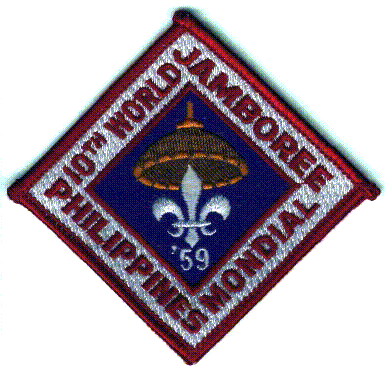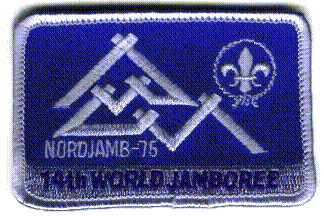Documentary Resources of World Scouting
World Organization of The Scout Movement
Documentary of Scout Jamboree :-
The World Scout Jamboree is a Scouting jamboree of the World Organization of the Scout Movement, typically attended by several tens of thousands of Scouts from around the world, aged 14 to 17. In Scouting, a jamboree is a large gathering of Scouts who rally at a national or international level. The 1st World Scout Jamboree was held in 1920, and was hosted by the United Kingdom. It was for this jamboree that the founder of scouting, Lord Baden-Powell, wrote the song "ging gang goolie" because it could be sung by anyone. Since then, there have been twenty two World Scout Jamborees, hosted in various countries, generally every four years. There are also national and continental jamborees held around the world with varying frequency. Many of these events will invite and attract Scouts from overseas.
The World Scout Jamboree "Around the World"
History :-
While World Scout Jamboree is the expression used by the World Organization of the Scout Movement, other organizations held events called "jamborees" for their members. The Scouting program became an international success following its founding by Robert Baden-Powell in 1907. With its continuing growth, the founder of the movement saw a need for a gathering of representatives of Scouting from all around the world. The general aim was to foster a worldwide brotherhood, and to help the young Scouts in the movement learn about other peoples and nations by direct interaction with them. The idea of organizing such periodical international gatherings was originally conveyed to Baden-Powell by the General Chief of the Scouts of Greece, Konstantinos ("Kokos") Melas, during the 1918 international Scout meeting, in England. Captain Melas proposed the gatherings should repeat every four years, in the same way Olympic Games were held in Ancient Greece. The suggestion was accepted with enthusiasm by Baden-Powell, who named the gatherings "Jamborees". However, the outbreak of the First World War in 1914 delayed any plans for such an event. It was not until 1920 that the first World Scout Jamboree could be realized. It was held in the Olympia halls in Kensington, London. Symbolically, the Jamboree site bore the name of the birthplace of the Olympic Games, Olympia. 8,000 Scouts from 34 countries attended the event. Thereafter, a Jamboree has been held every four years. There are two exceptions to this: no Jamboree was held between 1937 and 1947 because of the Second World War, and the 1979 Jamboree, which was to be held in Iran, was cancelled due to the political upheaval in the region at that time. The Jamboree has been held in different countries around the world. The first seven Jamborees were held in Europe. The eighth World Jamboree was held in North America where the tradition of moving the Jamboree among the continents began. As yet, Africa has not hosted a jamboree. To replace the cancelled event of 1979, the World Scout Committee determined that an alternative celebration, the World Jamboree Year should take place. Several regional camps took place, such as the 12th Australian/4th Asia-Pacific Jamboree, held in Perth, Western Australia, along with countless Join-in-Jamboree activities — designed to allow Scouts from around the world to participate in an activity that thousands of other Scouts around the world were also participating in at the same time. This Join-in programme is being reproduced again as part of the Scouting 2007 Centenary celebrations. So far, the greatest attendance of all Jamborees was in 1929, where over 50,000 members from around the world descended upon Birkenhead in the north-west of England. This number represented the permanent contingent who remained for the entire event. They were joined by hundreds of thousands of visiting Scouts who participated on a day basis. The first Jamboree was more akin to an exhibition of Scouting, allowing visitors to see how things were done in other parts of the world. The Second Jamboree was conducted on a camp basis and each successive Jamboree has developed on this format where the programme is typically more activity oriented, with plenty of time for Scouts from different nations to interact and learn about each other in less formal ways than an exhibition would allow. The 2007 Jamboree coincided with the Scouting Centenary celebrations. Because of this, the honour of hosting the event was again bestowed upon the United Kingdom, as the birthplace of Scouting. Over 40,000 young people camped in August at Hylands Park in Chelmsford, Essex. Hundreds of thousands of day visitors attended events in the south-east of England as part of the Jamboree. The following Jamboree was held at Rinkaby in Sweden, opening on 27 July 2011. The Jamboree in 2015 will be in Japan and the Jamboree in 2019 will be at The Summit Bechtel Family National Scout Reserve in West Virginia.
While World Scout Jamboree is the expression used by the World Organization of the Scout Movement, other organizations held events called "jamborees" for their members. The Scouting program became an international success following its founding by Robert Baden-Powell in 1907. With its continuing growth, the founder of the movement saw a need for a gathering of representatives of Scouting from all around the world. The general aim was to foster a worldwide brotherhood, and to help the young Scouts in the movement learn about other peoples and nations by direct interaction with them. The idea of organizing such periodical international gatherings was originally conveyed to Baden-Powell by the General Chief of the Scouts of Greece, Konstantinos ("Kokos") Melas, during the 1918 international Scout meeting, in England. Captain Melas proposed the gatherings should repeat every four years, in the same way Olympic Games were held in Ancient Greece. The suggestion was accepted with enthusiasm by Baden-Powell, who named the gatherings "Jamborees". However, the outbreak of the First World War in 1914 delayed any plans for such an event. It was not until 1920 that the first World Scout Jamboree could be realized. It was held in the Olympia halls in Kensington, London. Symbolically, the Jamboree site bore the name of the birthplace of the Olympic Games, Olympia. 8,000 Scouts from 34 countries attended the event. Thereafter, a Jamboree has been held every four years. There are two exceptions to this: no Jamboree was held between 1937 and 1947 because of the Second World War, and the 1979 Jamboree, which was to be held in Iran, was cancelled due to the political upheaval in the region at that time. The Jamboree has been held in different countries around the world. The first seven Jamborees were held in Europe. The eighth World Jamboree was held in North America where the tradition of moving the Jamboree among the continents began. As yet, Africa has not hosted a jamboree. To replace the cancelled event of 1979, the World Scout Committee determined that an alternative celebration, the World Jamboree Year should take place. Several regional camps took place, such as the 12th Australian/4th Asia-Pacific Jamboree, held in Perth, Western Australia, along with countless Join-in-Jamboree activities — designed to allow Scouts from around the world to participate in an activity that thousands of other Scouts around the world were also participating in at the same time. This Join-in programme is being reproduced again as part of the Scouting 2007 Centenary celebrations. So far, the greatest attendance of all Jamborees was in 1929, where over 50,000 members from around the world descended upon Birkenhead in the north-west of England. This number represented the permanent contingent who remained for the entire event. They were joined by hundreds of thousands of visiting Scouts who participated on a day basis. The first Jamboree was more akin to an exhibition of Scouting, allowing visitors to see how things were done in other parts of the world. The Second Jamboree was conducted on a camp basis and each successive Jamboree has developed on this format where the programme is typically more activity oriented, with plenty of time for Scouts from different nations to interact and learn about each other in less formal ways than an exhibition would allow. The 2007 Jamboree coincided with the Scouting Centenary celebrations. Because of this, the honour of hosting the event was again bestowed upon the United Kingdom, as the birthplace of Scouting. Over 40,000 young people camped in August at Hylands Park in Chelmsford, Essex. Hundreds of thousands of day visitors attended events in the south-east of England as part of the Jamboree. The following Jamboree was held at Rinkaby in Sweden, opening on 27 July 2011. The Jamboree in 2015 will be in Japan and the Jamboree in 2019 will be at The Summit Bechtel Family National Scout Reserve in West Virginia.
1st World Scout Jamboree
Olympia, London, England, 1920
Olympia, London, England, 1920
World Scout Jamboree :-
The 1st World Scout Jamboree was held from 30 July 1920 to 8 August 1920 and was hosted by the United Kingdom at Kensington Olympia in London. 8,000 Scouts from 34 nations attended the event, which was hosted in a glass-roofed building covering an area of 6 acres (24,000 m2). It was at this event that Baden-Powell, the founder of Scouting, was acclaimed the Chief Scout of the World.
The 1st World Scout Jamboree was held from 30 July 1920 to 8 August 1920 and was hosted by the United Kingdom at Kensington Olympia in London. 8,000 Scouts from 34 nations attended the event, which was hosted in a glass-roofed building covering an area of 6 acres (24,000 m2). It was at this event that Baden-Powell, the founder of Scouting, was acclaimed the Chief Scout of the World.
2nd World Scout Jamboree
Copenhagen, Denmark, 1924
Copenhagen, Denmark, 1924
The 2nd World Scout Jamboree was held from August 9 to 17, 1924 and was hosted by Denmark at Ermelunden.
3rd World Scout Jamboree
Arrowe Park, Birkenhead, England, 1929
Arrowe Park, Birkenhead, England, 1929
The 3rd World Scout Jamboree was held in 1929 at Arrowe Park in Upton, Merseyside, United Kingdom. As it was commemorating the 21st birthday of Scouting for Boys and the Scouting movement, it is also known as the Coming of Age Jamboree. With about 50,000 Scouts and over 300,000 visitors attending, this jamboree was the largest jamboree ever.
4th World Scout Jamboree
Godollo, Hungary, 1933
Godollo, Hungary, 1933
The 4th World Scout Jamboree a gathering of Boy Scouts from all over the world, was hosted by Hungary and held from 2 to 13 August 1933. It was attended by 25,792 Scouts, representing 46 different nations and additional territories. They encamped around the Royal Palace in the Royal Forest of Gödöllő, about 11 miles from the capital of Budapest.
5th World Scout Jamboree
Vogelenzang, Holland, 1937
Vogelenzang, Holland, 1937
The 5th World Scout Jamboree was the World Scout Jamboree where 81-year old Baden-Powell gave his farewell.
6th World Scout Jamboree
Moisson, France, 1947
The 6th World Scout Jamboree was held in 1947 and was hosted by France at Moisson. This was the first jamboree to have been held after Baden-Powell's death in 1941. It was originally planned to take place in 1941 in France.
7th World Scout Jamboree
Bad Ischl, Austria, 1951
Bad Ischl, Austria, 1951
The 7th World Scout Jamboree was held August 3 to 12, 1951 and was hosted by Austria at Bad Ischl. The attendance was 12,884 from 61 different parts of the world, with 675 German Scouts given a warm welcome as official participants in a World Jamboree for the first time. The Austrian contingent was slightly outnumbered by the Commonwealth contingent, and had reduced the minimum age for their attendees from 14, the normal Jamboree age, to 13, since the revived organization had only been in existence for five years.
8th World Scout Jamboree
Niagara-on-the-Lake, Canada, 1955
Niagara-on-the-Lake, Canada, 1955
The 8th World Scout Jamboree was held in 1955 and was hosted by Canada at Niagara-on-the-Lake, Ontario. The Jamboree saw the introduction of the World Membership Badge which is still worn on the uniforms of Scouts the world over.
9th World Scout Jamboree, The Jubilee Jamboree
Sutton Coldfield, Warwickshire,England, 1957
Sutton Coldfield, Warwickshire,England, 1957
The 9th World Scout Jamboree also known as the Jubilee Jamboree, was held at Sutton Park, Birmingham, England, for twelve days during August, 1957. The Jamboree marked dual milestones as it was both the 50th anniversary of the Scouting movement since its inception at Brownsea Island and the 100th anniversary of the birth of Scouting's founder Robert Baden-Powell. Held concurrently with the World Jamboree was the 2nd World Scout Indaba and the 6th World Rover Moot, as well as the third Girl Guide World Camp.
10th World Scout Jamboree
Laguna, Philippines 1959
Laguna, Philippines 1959
The 10th World Scout Jamboree was held 17-26 July 1959 and was hosted by the Philippines at Mount Makiling, Los Baños, Laguna. Dubbed "The Bamboo Jamboree" due to the prevalence of bamboo and nipa palm. There were a total 12,203 Scouts from 44 countries. The theme was "Building Tomorrow Today". It was the first World Scout Jamboree to be held outside Europe and Canada.
11th World Scout Jamboree
Marathon, Greece, 1963
Marathon, Greece, 1963
The 11th World Scout Jamboree was held in August 1963 and was hosted by Greece at Marathon. Demetrios Alexatos was the Camp Chief.
12th World Scout Jamboree
Farragut State Park, USA, 1967
Farragut State Park, USA, 1967
The 12th World Scout Jamboree was held July 31 to August 9, 1967 and was hosted by the United States at Farragut State Park, in the Rocky Mountains of Idaho. It was the second World Scout Jamboree to take place in North America.
13th World Scout Jamboree
Asagiri Heights, Japan, 1971
Asagiri Heights, Japan, 1971
The 13th World Scout Jamboree was held August 2–10, 1971, on Asagiri Heights on the western side of Mount Fuji, in Fujinomiya, Japan, approximately 80 miles southwest of Tokyo.
14th World Scout Jamboree
Lillehammer, Norway, 1975
Lillehammer, Norway, 1975
The 14th World Scout Jamboree was held July 29 to August 7, 1975 and was hosted by Norway at Lillehammer, on the shore of Lake Mjøsa.
15th World Scout Jamboree
Kananaskis Country, Canada, 1983
Kananaskis Country, Canada, 1983
The 15th World Scout Jamboree was held in 1983 and was hosted by Canada at Kananaskis, Alberta, an area of Provincial Park 4,000 feet in the foothills of the Rocky Mountains, 80 miles west of Calgary, Alberta.
16th World Scout Jamboree
Cataract Park, Sydney, Australia, 1987-88
Cataract Park, Sydney, Australia, 1987-88
The 16th World Scout Jamboree was held 30 December 1987 to 7 January 1988, the first World Scout Jamboree held in the Southern Hemisphere, and the first to change the date from the traditional August to January to coincide with summer. The Jamboree was hosted by Australia at Cataract Scout Park a specially constructed Scout tent city situated on a 160-hectare site at Appin, New South Wales, near Sydney, New South Wales. 14,434 Scouts from 84 countries attended the Jamboree, with around 13,000 more in attendance on "Visiting Day". The theme was Bringing the World Together.
17th World Scout Jamboree
Mount Sorak National Park, South Korea, 1991
Mount Sorak National Park, South Korea, 1991
The 17th World Scout Jamboree was held August 8 to 16, 1991 and was hosted by South Korea at Soraksan National Park, near the border with North Korea, and some 200 km, six hours by road, from Seoul.
18th World Scout Jamboree
The Netherlands, 1995
The Netherlands, 1995
The 18th World Scout Jamboree was held August 1 to 11, 1995 and was hosted by the Netherlands on a polder near Dronten, Flevoland. 28,960 Scouts and staff members from 166 countries and territories participated in the event, the largest representation of countries to date, including 34 countries where Scouting was being born or reborn.
19th World Scout Jamboree
Chile 1999
Chile 1999
The 19th World Scout Jamboree in Chile, the first ever in South America, took place at a 7,400-acre (30 km2) site in the foothills of the Andes, some 38 miles (61 km) south of the capital city of Santiago. For 11 days, from 27 December 1998, to 6 January 1999, approximately 31,000 Scouts and leaders from nearly every Scouting association in the world assembled for this 4-yearly event.
20th World Scout Jamboree
Thailand, 2002/3
Thailand, 2002/3
The 20th World Scout Jamboree took place in the naval base in Sattahip, Thailand. It was the second World Jamboree to be held in Southeast Asia after the Philippines hosted the event in 1959. The Jamboree provided an opportunity for 30,000 Scouts from all over the world to spend 12 days camping together and attend activities designed for them in self-development and social responsibility, within the framework of the educational Scout method. The Jamboree fostered the progress and unity of World Scout Movement and strongly linked it to Asian culture, both in terms of activities, mainly Thai dancing, and method . The theme of the 20th World Scout Jamboree was Share our World, Share our Cultures. As with previous Jamborees, the standard troop size was 36 youths plus 4 adult leaders. The 20th World Scout Jamboree was held in Sattahip, Chonburi Province, about 180 km southeast of Bangkok. The camp site was located on a beach on the Gulf of Thailand, covering 1,200 hectares and consisting of flat plains, foothills and a white sandy beach. The emblem shows a typical Thai roof. The A-shaped gables in the roof represent Thailand's development of traditions and cultures and the sharing of these traditions from generation to generation.
21st World Scout Jamboree
United Kingdom, 2007
United Kingdom, 2007
The 21st World Scout Jamboree was held in July and August 2007, and formed a part of the Scouting 2007 Centenary celebrations of the world Scout Movement. The event was hosted by the United Kingdom, as 2007 marked the 100th anniversary of the founding of Scouting on Brownsea Island.
22nd World Scout Jamboree
Sweden 2011
Sweden 2011
The 22nd World Scout Jamboree took place in Rinkaby, Kristianstad, Scania in southern Sweden from 27 July to 7 August 2011. The theme was Simply Scouting. 40,061 Scouts, leaders and adult volunteers participated from 166 different countries.
23rd World Scout Jamboree
Japan July 28 to August 8, 2015
The 23rd World Scout Jamboree will take place at Kirara-hama, Yamaguchi, Japan in 2015. The theme will be Wa: A Spirit of Unity. The kanji, meaning harmony, unity or togetherness, is also a part of the theme. Wa is also an early name for Japan.
24th World Scout Jamboree
United States 2019
The 24th World Scout Jamboree will be held at the Summit Bechtel Family National Scout Reserve in West Virginia during the summer of 2019. The hosting duties will be split between the United States, Canada, and Mexico. The theme is Unlock a New World.
Etymology :-
According to the Canadian Oxford Dictionary, the etymology is "19th century, origin unknown". The OED identifies it as coming from American slang and identifies a use in the New York Herald in 1868 and in Irish writings later in the 19th century. Robert Graves in The Crowning Privilege: The Clark Lectures, 1954–1955 suggests Baden-Powell might have known the word through his regiment's Irish links rather than from the US slang. Poet Robert W. Service used the term well before the first Scouting jamboree. It appears in the poem "Athabaska Dick" in his Rhymes of a Rolling Stone, which was published in 1912. At the time, the word meant a rowdy, boisterous gathering. Baden-Powell was once asked why he chose "jamboree". He replied, "What else would you call it?", a response that makes sense if the word already means a boisterous gathering. Nonetheless, it is popularly believed within the Scout Movement that the word was coined by Baden-Powell. It is said that the word has several possible origins, ranging from Hindi to Swahili to Native American dialects. It is also said that the word is related to corroboree, a term corrupted by the European settlers of Australia from the Aboriginal word caribberie meaning a ceremonial meeting of Aboriginals involving singing and dancing. Baden-Powell chose the name as rally, meeting and gathering did not fully capture the spirit of this then-new concept. It is said that the name is derived from the Swahili for hello, jambo, as a result of the considerable amount of time he spent in the region. At the first world jamboree at Olympia in 1920, Lord Baden-Powell said "People give different meanings for this word, but from this year on, jamboree will take a specific meaning. It will be associated to the largest gathering of youth that ever took place." Olave, Lady Baden-Powell, coined the term jamborese to refer to the lingua franca used between Scouts of different languages and cultural habits, that develops when diverse Scouts meet, that fosters friendship and understanding between Scouts of the world. Sometimes the word jamborette is used to denote smaller, either local or international, gatherings. Girl Guides rarely use the term jamboree for their gatherings. Girl Scouts, however, do use the word.
According to the Canadian Oxford Dictionary, the etymology is "19th century, origin unknown". The OED identifies it as coming from American slang and identifies a use in the New York Herald in 1868 and in Irish writings later in the 19th century. Robert Graves in The Crowning Privilege: The Clark Lectures, 1954–1955 suggests Baden-Powell might have known the word through his regiment's Irish links rather than from the US slang. Poet Robert W. Service used the term well before the first Scouting jamboree. It appears in the poem "Athabaska Dick" in his Rhymes of a Rolling Stone, which was published in 1912. At the time, the word meant a rowdy, boisterous gathering. Baden-Powell was once asked why he chose "jamboree". He replied, "What else would you call it?", a response that makes sense if the word already means a boisterous gathering. Nonetheless, it is popularly believed within the Scout Movement that the word was coined by Baden-Powell. It is said that the word has several possible origins, ranging from Hindi to Swahili to Native American dialects. It is also said that the word is related to corroboree, a term corrupted by the European settlers of Australia from the Aboriginal word caribberie meaning a ceremonial meeting of Aboriginals involving singing and dancing. Baden-Powell chose the name as rally, meeting and gathering did not fully capture the spirit of this then-new concept. It is said that the name is derived from the Swahili for hello, jambo, as a result of the considerable amount of time he spent in the region. At the first world jamboree at Olympia in 1920, Lord Baden-Powell said "People give different meanings for this word, but from this year on, jamboree will take a specific meaning. It will be associated to the largest gathering of youth that ever took place." Olave, Lady Baden-Powell, coined the term jamborese to refer to the lingua franca used between Scouts of different languages and cultural habits, that develops when diverse Scouts meet, that fosters friendship and understanding between Scouts of the world. Sometimes the word jamborette is used to denote smaller, either local or international, gatherings. Girl Guides rarely use the term jamboree for their gatherings. Girl Scouts, however, do use the word.


















































